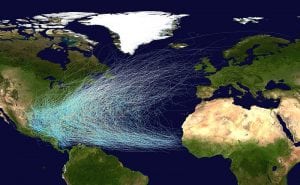The calm before the storm? The National Hurricane Center (NHC) predicts that tropical cyclones will not be observed during the next two days in the Atlantic Ocean. But AccuWeather warns that new storms could pose a threat to the western Caribbean and to the Florida state in mid-October. According to the NHC, the hurricane season, as a rule, runs from June 1 to November 30. Consequently, there are still as many as 2 months for the formation of even one cyclone. “In mid-October, many factors will connect, which can contribute to the creation of several tropical systems”, – said the senior meteorologist AccuWeather Alex Sosnowski.
Within a few weeks, Central America and the western part of the Caribbean will be characterized by low pressure and tropical moisture. These two indicators will lead to the circulation of the ocean, which can contribute to the development of the storm. Residents of Central America, Cuba, the Bahamas, Mexico and the southeast of the United States, experts advise to monitor these indicators, because they can provoke dangerous natural phenomena.

This map shows the routes of all the hurricanes in the Atlantic, which were formed between 1851 and 2012. wikimedia.org
How do hurricanes get their names?
Sosnovski said that the waters of the ocean will remain warm for many weeks. If a tropical cyclone is formed in this region, the warm water will provide the necessary fuel for its development. On the formation of the storm will still affect the speed and direction of the winds. “Tropical threats from the coast of Africa, which formed hurricanes Harvey, Irma and Maria, will continue to weaken in the coming weeks,” Sosnowski assured. If the cyclone becomes a storm, it will be named Nate. Recall, the season of Atlantic hurricanes in 2017 was the most unsuccessful for sushi. The most powerful hurricanes of the 5th category directly struck six sites, and in each case they devastated them.
Katrina, Andrew, Camilla, Sandy, Ike – because of their devastating consequences, these Atlantic hurricanes have gained worldwide fame. This year, the list of famous natural disasters added to the deadly Harvey, Irma and Jose. Have you ever wondered on what principle the hurricanes are called and how meteorologists define the name of each emerging threat?
Light on this secret was shed by Dan Kotlovski, a specialist from Accuweather with 40 years of experience. The weatherman explained how the algorithm arose and on what principle it works.
Even during World War II, US authorities noticed that they were losing a lot of warships in the western Pacific. The reason was the hurricanes. After the end of hostilities, many studies were carried out to better understand the nature of natural disasters. Then the military began to give them names. First, only the alphabet was used for these purposes, but in 1979 the World Meteorological Organization decided to standardize the method. Scientists began to call storms human names in alphabetical order, using their repeated list. The system works in different ways, depending on where the elements are raging – in the Atlantic or Pacific Ocean. For both regions, there is a general rule: to get a name, a storm must be accompanied by a steady wind speed of at least 39 miles per hour. Storms with less intense wind are called tropical depressions – they are not given names.
For Atlantic hurricanes, there is a list of their 21 names, which alternate in alphabetical order (there are no names in the list that begin with the letters Q, U, X, Y and Z). So, this year the hurricane season opened the storm Arlene, followed by Bret, Cindy, Don, Emily, Franklin. Today, the turn came to Nate – by the weekend it can grow into a hurricane of the 1st category. If in a certain year the list stops on some letter, for example, R (Rina) then next year the names of the storms begin with the next – S (Sean). During particularly turbulent seasons, such as in 2005, the names on the list may not be enough. In such cases, the remaining storms are called according to the Greek alphabet.
Curiously, hurricanes with female names are more deadly. In this there is no mysticism – according to the research of the American National Academy of Sciences, people underestimate the threat, and because of this, often are ill-prepared.
